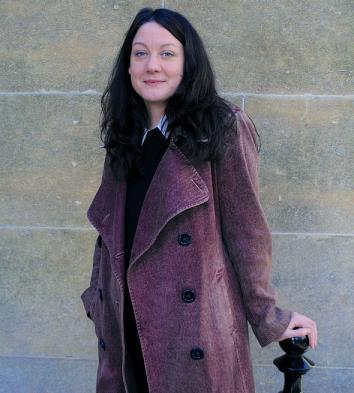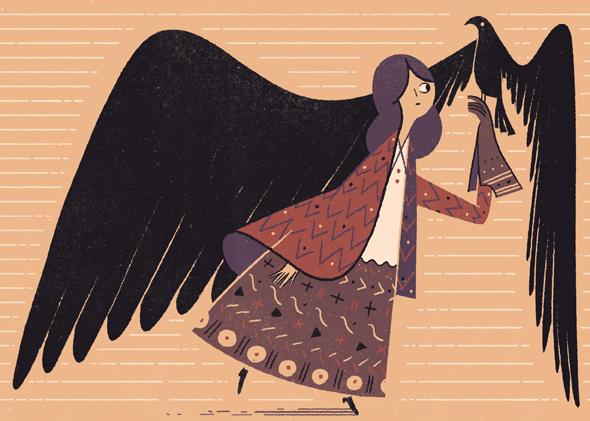Some books are not books—
I am intimidated to begin this review. I am scared to approach something so gimlet-eyed, something with a vision so different—richer, wilder, more precise—than my own. I’m supposed to recognize it, but I don’t, quite; it could mean any number of things, and—as in the best poetry—those things are somehow inseparable from the expression the writer has already given them.
The hawk-book’s form is perfect. It prickles your skin the way nature can when you are surprised by an animal in your path. Some books are not books but visitations, and this one has crossed its share of thresholds before arriving here, to an impossible middle perch between wilderness and culture, past and present, life and death.
If the title of Helen Macdonald’s memoir H Is for Hawk evokes a tidy, elementary school correspondence, don’t be fooled. Hawk is for everything. Not only does the creature Macdonald ties herself to in the wake of her father’s death come to represent the entire range of her grief, fury, and love, but it also stands for England, imagination, aristocracy, manhood, and T.H. White. It stands as well for the opposite of these. And then—while you are scrambling to grasp that T.H. White, beloved children’s author and broken sadist, is his own opposite—it shakes the symbolism from its feathers like rainwater.
When Macdonald, a Cambridge lecturer, poet, and naturalist, was in her late 30s, she lost her father to a heart attack on a London street. Then she lost herself. Torn by grief, she acquired a goshawk—a huge, bloodthirsty dinosaur, “the birdwatchers’ dark grail”—to plug the wound. Macdonald, an experienced falconer, withdrew from people to train her murderess, transforming her fridge into a morgue for raw animal parts. As she did, she also reread a volume from her childhood, The Goshawk. It’s an early work by The Once and Future King author T. H. White, chronicling a failed attempt to train Gos, his ghastly, gorgeous bird of prey. Macdonald and White have other things in common. They are academics, recluses, tormented by unworkable yearnings—she for her dead father’s return, he for gay BDSM. Their hawks embody what they want to be, and are not. In Macdonald’s case, that means a creature “solitary, self-possessed, free from grief.” In White’s, she guesses: “He wanted to be ferocious. He wanted to be fey, a fairy, ferox. All those elements of himself he’d pushed away, his sexuality, his desire for cruelty, for mastery: all these were suddenly there in the figure of the hawk.”
So the plan seems straightforward enough. Macdonald, bereft, will settle her score with death by becoming it. She will turn over her humanity to an ancient monster (“a reptile. A fallen angel”), quit answering the phone, focus on every feather-shuffle or mood-shift, and let the bird’s “brilliance and fury” burn away her hurt. Her father, after all, was a photojournalist, accustomed to transforming scenes of suffering into stark and beautiful images. He could find the form in madness, the grace in a fighter plane’s lethal line of descent. In a war zone, writes Macdonald, Alisdair M’s single-minded purpose protected and distanced him. He used to instruct her: “Look through the viewfinder. Stops you being involved. Stops you being scared.” For months, Macdonald’s goshawk serves as her viewfinder, its education her one duty, its “armoured pianist fingers” (what a phrase!) extracting the music from her pain.
But the narrator’s efforts to wild herself via mind-meld with “a spooky pale-eyed psychopath” have a corollary. She is also training, or (ahem) manning, her bird—a job that entails transforming sun-bright savagery into something resembling obedience, even loyalty. Macdonald names the goshawk Mabel—“derived from amabilis, meaning lovable, or dear”—and teaches it to play catch with crumpled paper. She trains it to flap contentedly to her arm at the sound of a whistle. It turns out the avian U-Boat, despite its awesome belligerence and ruthless instinct, can also be pretty cute. “She bounces back on the perch with brio, all shaggy trousers and waggy tail,” Macdonald aws. Unsurprisingly, given the book’s wish to complicate its own symbolism, woman and hawk are not so much opposites as creatures jointly pulled between two poles: solitude and sociability, ferocity and love. The same leather jesses—and hail the incantatory twinkle of this book’s falconry words! Bate, rouse, eyeasse, haggard—that bind Mabel to the human world also allow her to fly.
Because hawks fly. That is what they do. And sometimes they don’t come back. (More on this later.) People, though, at least according to the myths and traditions that breathe their soft dust over Macdonald’s prose, fall. They fall on streets in Battersea, clutching their chests; or they fall from grace, or into love. T.H. White wrote another book, the narrator tells us, a thinly veiled memoir in which a failed schoolteacher encounters a mysterious man on the side of the road. The stranger tells the screw-up not to worry about the ways he’s botched his time in academia. What he stands to gain from education—the fraught process that White pursued both with his students and with his bird—isn’t wisdom or (proper, heterosexual) manhood. It’s love. “He is a wicked man. A free man,” Macdonald writes, and it’s unclear whether she’s describing the stranger in the story or White himself. “His name … is Lucifer … the light-bringer, the fallen angel, the devil incarnate.”
Lucifer-as-hawk hovers over the whole book, an unanswered question. What should we make of this murderous, dark, glorious flyer? If he is showing White and Macdonald how to fall, where or what are they falling to?

Photo by Marzena Pogorzaly
But one would need a perception as keen as a hawk’s, perhaps, to track the multitudinous meanings proliferating around Mabel, even as the author makes each one glow in turn. (And Mabel, “bright and distant, like gold falling through water,” would probably tell you that the loveliest apprehensions are fugitive anyway). That’s OK: Despite the contradictions and shape shifting that allow H Is for Hawk to elude domestication, it still feels wonderfully unified, weaving together biography, history, literary criticism, grief memoir, field guide. And ghost story.
H is for haunted. “Something else was there,” Macdonald frets in the opening pages of her book, just after she loses her father. “Something standing next to me that I couldn’t touch or see.” Presences multiply as the narrative courses ahead: T. H. White and his hawk, King Arthur and his hawks, all the men and all the hawks of England’s historical and mythological past. And Alisdair, the central revenant, counts as a spook in another sense. He’s a spy or observer. A “watcher,” as Macdonald puts it. The old falconers called the process of accustoming a hawk to a human “watching.” Perhaps the narrator, a “girl … who loved to disappear,” belongs in the crowd of spirits too.
Yet nothing is ghostlier than the hawk itself. “You might spend a week in a forest full of gosses and never see one, just traces,” marvels Macdonald. They are aerial whispers, snaps of wind; they seem to slip “out of our world entirely … into another, wilder world from which humans had been utterly erased.” Mabel’s ethereality makes every training flight an agony for her keeper: “I feared the veering off … there was nothing that was such a salve to my grieving heart as the hawk returning.” We are allowed to realize why this is long before the author articulates it, in a cursively luminous passage that is like ice cracking. Mabel can traverse heaven and earth; she can pass “slant-wise into nothing” through a rent in the sky. “I’d wanted to fly with the hawk to find my father,” she admits; “find him and bring him home.”
H Is for Hawk is a ghost story not just because of the mesmerizing ghost-tangle it convenes. It also borrows the logic of the genre, presenting its phantoms as tragic, but dangerous too. With each rush of predatory fierceness, Mabel shows Macdonald how to conflate death with the dead, the raptor with the rapt. She (the hawk) represents something irrational, painful, and true about losing a loved one: In his sudden absence, a snatched-away father is viciously, unbearably cruel.
But he is also, improbably, the light-bringer, an agent of love. Here is one last glimpse of Mabel, settling in to roost for the summer: “She looks down at my hand as it pulls each jess free from her ankles. … Her eyes, when I see her next, will be the deep orange of glowing coals. Everything changes. Everything moves.” Unlike the ghost in a horror story, Macdonald’s hawk will not drag her into the world of the dead. She will let Helen fall into the human, where a house on the edge of the forest is lit and warm, and T.H. White’s book is on the table, and there is time not just for once, but future.
__
H is for Hawk by Helen Macdonald. Grove Press.
See all the pieces in this month’s Slate Book Review.
Sign up for the Slate Book Review monthly newsletter.
